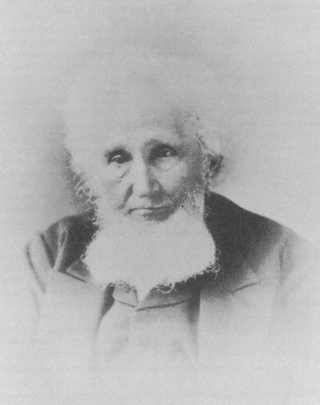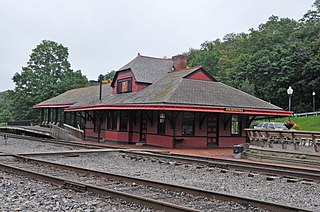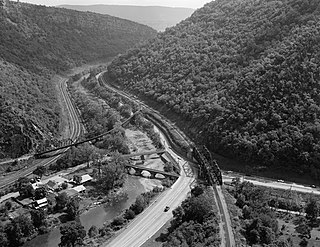
Frostburg is a city in Allegany County, Maryland. It is located at the head of the Georges Creek Valley, 8 miles (13 km) west of Cumberland. The town is one of the first cities on the "National Road", US 40, and the western terminus of the Western Maryland Scenic Railroad. It is part of the Cumberland metropolitan area.

A steam locomotive is a locomotive that provides the force to move itself and other vehicles by means of the expansion of steam. It is fuelled by burning combustible material to heat water in the locomotive's boiler to the point where it becomes gaseous and its volume increases 1,700 times. Functionally, it is a steam engine on wheels.

The Shay locomotive is a geared steam locomotive that originated and was primarily used in North America. The locomotives were built to the patents of Ephraim Shay, who has been credited with the popularization of the concept of a geared steam locomotive. Although the design of Ephraim Shay's early locomotives differed from later ones, there is a clear line of development that joins all Shays. Shay locomotives were especially suited to logging, mining and industrial operations and could operate successfully on steep or poor quality track.

Baldwin Locomotive Works (BLW) was an American manufacturer of railway locomotives from 1825 to 1951. Originally located in Philadelphia, Pennsylvania, it moved to nearby Eddystone in the early 20th century. The company was for decades the world's largest producer of steam locomotives, but struggled to compete when demand switched to diesel locomotives. Baldwin produced the last of its 70,000-plus locomotives in 1951, before merging with the Lima-Hamilton Corporation on September 11, 1951, to form the Baldwin-Lima-Hamilton Corporation.

A 2-8-8-4 steam locomotive, under the Whyte notation, has two leading wheels, two sets of eight driving wheels, and a four-wheel trailing truck. The type was generally named the Yellowstone, a name given it by the first owner, the Northern Pacific Railway, whose lines ran near Yellowstone National Park. Seventy-two Yellowstone-type locomotives were built for four U.S. railroads.

A camelback locomotive is a type of steam locomotive with the driving cab placed in the middle, astride the boiler. Camelbacks were fitted with wide fireboxes which would have severely restricted driver visibility from the normal cab location at the rear.
Midlothian is an unincorporated community and census-designated place (CDP) in Allegany County, Maryland, United States; at one time it was called Midlothian Junction. As of the 2010 census it had a population of 320. Its ZIP code is 21543.

The Western Maryland Scenic Railroad (WMSR) is a heritage railroad based in Cumberland, Maryland, that operates passenger excursion trains and occasional freight trains using both steam and diesel locomotives over ex-Western Maryland Railway (WM) tracks between Cumberland and Frostburg. The railroad offers coach and first class service, murder mystery excursions, and special seasonal trips.

Ross Winans (1796–1877) was an American inventor, mechanic, and builder of locomotives and railroad machinery. He is also noted for design of pioneering cigar-hulled ships. Winans, one of the United States' first multi-millionaires, was involved in national and state politics, a southern-sympathizer and was a vehement "states' rights" advocate. Winans was briefly arrested after the Baltimore riot of 1861. His outspoken anti-federal stance as a member of the Maryland House of Delegates, the lower chamber of the General Assembly, led to his temporary arrest on May 14, 1861. At the time of his arrest, Winans was returning on a Baltimore and Ohio Railroad train from an early session of the legislature that was being held in the western Maryland town of Frederick to avoid the Union Army-occupied state capital of Annapolis in April–May 1861 to consider the possibilities of state secession during the early decisive period of the American Civil War. Winans was related to James McNeill Whistler through marriage.
James Allaire Millholland, the son of James Millholland, was an American railroad executive, serving as General Manager and later President of the Georges Creek and Cumberland Railroad in Cumberland, Maryland, USA, which served coal mines in the Georges Creek Valley.

James Millholland (1812–1875) was an American railway master mechanic who is particularly well known for his invention of many railway mechanisms. His association with the Philadelphia and Reading Railroad Company as master machinist spanned fifty years in the early development of the American railroad. He also founded the locomotive shops at Mount Savage, Maryland, the center of the Cumberland and Pennsylvania Railroad.

The Cumberland and Pennsylvania Railroad (C&P) was an American railroad which operated in Western Maryland. Primarily a coal hauler, it was owned by the Consolidation Coal Company, and was purchased by the Western Maryland Railway (WM) in 1944.

Mount Savage is an unincorporated community and census-designated place (CDP) in Allegany County, Maryland, United States. As of the 2010 census it had a population of 873.

The Maryland Mining Company is a historic coal mining, iron producer and railroad company that operated in Allegany County, Maryland, United States.

The Eckhart Branch Railroad was a railroad that operated in the Cumberland, Maryland area in the 19th century.
The Mount Savage Railroad was a railroad operated by the Maryland and New York Coal and Iron Company of Mount Savage, Maryland between 1845 and 1854. The 14.9 miles (24 km) rail line ran from Frostburg to Cumberland, Maryland.
The Georges Creek Railroad was a railroad operated by the Georges Creek Coal and Iron Company in Western Maryland. The railroad operated from 1853 to 1863, when it was acquired by the Cumberland and Pennsylvania Railroad (C&P).

The Mount Clare Shops is the oldest railroad manufacturing complex in the United States, located in Baltimore, Maryland. It was founded by the Baltimore and Ohio Railroad (B&O) in 1829. Mt. Clare was the site of many inventions and innovations in railroad technology. It is now the site of the B&O Railroad Museum. The museum and Mt. Clare station were designated a National Historic Landmark in 1961.
Thomas Haig Paul was a locomotive manufacturer in Frostburg, Maryland. He is credited with building the first narrow-gauge locomotive in the United States in 1864.

Western Maryland Scenic Railroad No. 734, also known as Mountain Thunder, is an SC-1 class 2-8-0 “Consolidation” type steam locomotive originally built by the Baldwin Locomotive Works in 1916 for the Lake Superior and Ishpeming Railroad (LS&I) as No. 18. It was renumbered to 34 in 1925. No. 34 was used to pull heavy iron ore trains for the LS&I, until it was retired in 1961. The locomotive was subsequently sold to the Marquette and Huron Mountain Railroad, where it was stored in a sideline alongside other LS&I steam locomotives. In 1971, No. 34 was sold to the Illinois Railway Museum for static display.














